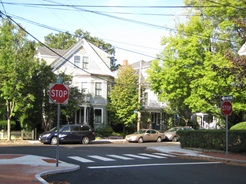Traffic Calming Program

Traffic Calming
The goal of traffic calming projects is to improve the quality of life in neighborhoods and allow cars to peacefully coexist with other modes of transportation. Traffic calming involves the creation of physical and visual cues, such as speed tables, sidewalk neck downs, and roadway markings which slow the speed of traffic and increase safety. The City generally considers implementing these streetscape changes at the request of community members, with construction often taking place in the course of other projects, such as street repaving and sewer reconstruction. See below for the Traffic Calming Request form.
Traffic calming is a way to design streets, using physical measures, to encourage people to drive more slowly, in order to provide a more livable environment and allow people to walk and bicycle more comfortably and safely. Traffic calming creates physical and visual cues that induce drivers to travel at slower speeds and is self-enforcing. The design of the roadway results in the desired effect, without relying on compliance with traffic control devices such as signals and signs, or on enforcement. While elements such as landscaping and lighting do not force a change in driver behavior, they can provide the visual cues that encourage people to drive more slowly.
The reason traffic calming is such a powerful and compelling tool is that it has proven to be so effective. Some of the effects of traffic calming, such as fewer and less severe crashes, are clearly measurable. Others, such as supporting community livability, are less tangible, but equally important.
Experience throughout North America, Europe and Australia, and has shown that traffic calming, if done correctly, reduces traffic speeds, the number and severity of crashes, and noise levels. Research on traffic-calming projects in the United States supports their effectiveness at decreasing automobile speeds, reducing the number and severity of crashes, and reducing noise levels for specific contexts. Looking at a sample of various speed studies shows that typical speed reductions of 5 to 20 percent at the 85th percentile speed can be realized by the use of traffic-calming measures—including mini-circles, chicanes, speed tables and other standard traffic-calming devices. Use of several of the traffic-calming measures have also resulted in substantial reductions in motor vehicle crashes.
Examples of Traffic Calming Techniques
Two common elements of traffic calming projects in Cambridge are raised devices (raised crosswalks and raised intersections) and curb extensions.
Traffic Calming Projects (Click links for more details)
Under Design
Under Contract/Construction
Completed Projects
Older Projects Completed
Traffic Calming Resources
For More Information
For more information about Traffic Calming contact Juan Avendano, javendano@cambridgema.gov, at 617/349-4655.